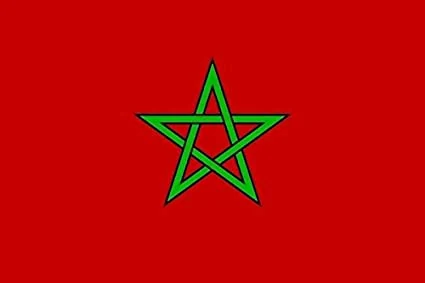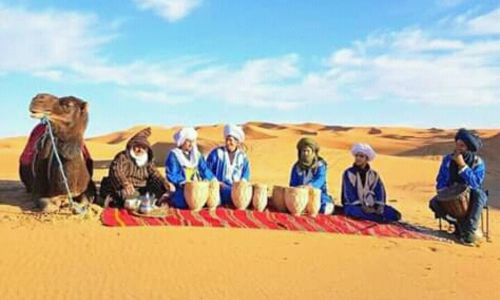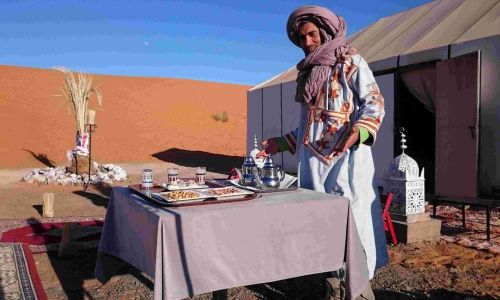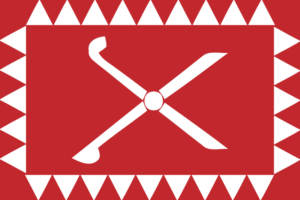January 11 Independence Manifesto Watiqat al-Istiqlal Delivered in 1944.
May 1 Labor Day Aid ach-Shoghl A public holiday.
July 30 Throne Day Aid al-Arch This is the most important civil holiday in Morocco. This traditional ceremony was held on March 3 during the time of Hassan II, and was inaugurated in 1934 by Moroccan nationalists who wanted to defy the French authorities who ruled Morocco
August 14 Allegiance of the Oued Eddahab Dikrat Istirjaa Ouad ad-Dahab marks the return of the Saharan provinces to Morocco.
August 20 The revolution of the king and the people Thawrat al-Maliki wa ach-Chaāb It recalls the deportation of Sultan Mohammed V, after his removal by the French authorities in 1953, this event had caused a surge of national fervor in the population outraged by this gesture of the occupying power. Today fireworks are lit and military parades are organized throughout the Kingdom of Morocco to show its military might, and the inhabitants all display flags with the national colors to show their faith in their country and their king. It is also one of the most important celebrations of the year.
The Flag of Morocco
The Flag of Morocco, is a flag serving as emblem of the Kingdom of Morocco since 1915. It is red with a green star in the middle, with five branches.
Originally entirely red, this historical emblem of the Alawite dynasty in power since the seventeenth century was given a green pentagram in its center in 1915 by Sultan Moulay Youssef, three years after the beginning of the French protectorate in Morocco, in order to distinguish it from the colors used in the French navy.

Contents
1 The current flag and its origins
2 Description of the flag
3 Symbolism
4 Protocol and uses
4.1 The royal standard
4.2 The days when the kingdom flies the flag
4.3 A custom probably of Spanish origin
5 History
5.1 Before the Muslim conquest (before the 8th century)
5.2 First flag during the Islamic conquest (8th and 9th centuries)
5.3 Almoravids
5.4 Almohads
5.5 Marinids and Saadians
5.6 From 1350 to 1895
5.6.1 Flag from 1895 to 1905
5.6.2 Version with a six-pointed star
5.6.3 Since 1915
5.7 The coat of arms of the Kingdom
5.8 In the Royal Armed Forces
5.9 Civilian flags of the protectorate era
6 Anecdote
The current flag and its origins
The pentagram.
In the seventeenth century, when Morocco was under the rule of the Alawite dynasty, its flag was a solid red color. This was the color used as a reference by the Meccan Cherifim. The flag will keep it until the time of the French protectorate because of its similarity with the colors of the French Navy.
The current green five-pointed star was introduced on November 17, 1915 by a dahir of Sultan Moulay Youssef3,4,5 , a little more than three and a half years after the beginning of the protectorate.
This star is found on the coat of arms of Morocco, between two lions. The current flag of Morocco generally bears the green star symmetrical to the vertical median axis. It is also sometimes presented with the green star symmetrical to the horizontal median axis, the axial point is then directed towards the floating part. This variant was seen in front of the royal mausoleum in Rabat.
Description of the moroccan flag
Construction sheet.
The Moroccan flag is defined in Article 7 of the 1962 to 1996 constitutions and in Article 4 of the 2011 constitution as follows: “The red flag with a green five-pointed star in its center.
In the center of the flag is an imaginary circle with the five-pointed star at its center, which is one third of the width of the flag.
Symbolism of the Moroccan flag
The red background of the Moroccan flag is the color of the Alawites. The five-pointed star represents the “seal of Solomon”. It was by a dahir on November 17, 1915, that the Moroccan Sultan Moulay Youssef decided to add a star representing the seal of Solomon (Souleyman in Arabic):
“We have decreed to distinguish Our flag by adorning it in the center with the five-pointed seal of Solomon, in green color. God lead this emblem in the ways of prosperity and glory, now and in the future.”
As for the green color of the star, it stands for hope and courage.
Protocol and Usage
The Royal Standard
The Royal Standard of Morocco is a national flag whose green segments of the star are bordered by a thin golden border.
The days when the kingdom flags
Detailed article: Festivals and public holidays in Morocco.
The Moroccan flag is permanently hoisted on all public and military buildings. It is also hoisted in the streets during the King’s travels, during national holidays and during specific events: inaugurations or visits of foreign heads of state.
Flag Parade
August 21 Youth Day Aid ach-Chabab King Mohammed VI’s birthday
November 6 The Green March Al-Massira al-Khadrae since 1975
November 18 Independence Day Aid al-Istiqlal the end of the French protectorate over Morocco in 1955 (National holiday of the country)
A custom probably of Spanish origin
In Morocco, rolls of red cloth are made with the national green star at regular intervals. This fabric is used in two different ways. It can be cut into rectangles with a green star in the center and attached to poles to make flags. These rolls can also be used to roll out long strips decorated with several green stars and to adorn the top of a triumphal arch or the parapet of a bridge with these banners. This is how the Spaniards decorate the balustrades of bullfighting arenas with long banners in their national colors.
History of the flag of Morocco
Before the Muslim conquest (before the seventh century)
The first known inhabitants of Morocco were Berber tribes. The Phoenicians had established trading posts around the eleventh century B.C., among them Carthage (now Tunisia). The Romans destroyed Carthage in 146 B.C., but the cultural influence of the Romans in Morocco was quite weak. In 429, the Vandals from Spain invaded Morocco, and in 534 incorporated it into the Byzantine Empire.
First moroccan flag during the Islamic conquest (seventh and ninth centuries)
In the early seventh century, the Arab commander Moussa Ibn Noçaïr conquered Tangier, installed a governor there, and introduced Islam to Morocco. The Berbers were converted, but revolted in 740, founding an independent principality in the Rif mountains. Princes Idriss I (died 791) and Idriss II (died 828) ruled all Berber tribes and spread the Muslim faith. The Idrissides (789-985) founded the city of Fez, and made it their political, economic and religious capital. The Idrisid dynasty soon lost its influence and power over Morocco after the death of Idriss II. Power was then contested throughout the tenth century between the Fatimids of Ifrikya (now eastern Algeria and Tunisia) and the Umayyads of al-Andalus.
The first Moroccan flag was established during the Muslim era, but was then a simple white silk banner, used on the battlefield.9 Sometimes these flags were decorated with a number of different designs.
Sometimes these flags were adorned with Qur’anic inscriptions.
Flag of the Almoravids from 1073 to 1147.
In 1062, the Almoravid Berbers of southern Morocco invaded the plains of southern Morocco. The word Almoravides comes from the Arabic Al Mourabitoun which means “those who live in a pious community in a ribat”. The ribat in fact is both a military garrison and a pious community. The Almoravid dynasty was thus formed around a marabout, a spiritual master, Sheikh Abdallah Ibn Yassine. The first of its leaders was Youssef Ibn Tachfin, who founded the city of Marrakech in 1062. The Almoravids ruled part of North Africa and Andalusia from 1061 to 1147.10 They initially imposed a very strict Islam but the exercise of political power gradually led them to moderate their doctrine.
It was under the Almoravid dynasty that the flag was first used9 in Morocco as a state symbol. Prior to this, white silk banners were taken to the battlefields, sometimes with Qur’anic inscriptions: this was a devotional practice. The Almoravids institutionalized the political and military use of the flag. Each group of 100 soldiers had a banner9 and the leaders carried a banner with the inscription: “There is no God but God himself, and Mohamed is his prophet. (shahada). The two dynasties that followed (the Marinids and the Saadians) continued the use of the white flag as a dynastic symbol.
Almohads
Flag of the Almohads decorated with a chessboard.
The Almohads were a Berber Muslim dynasty that ruled the Maghreb from 1121 to 1269.
The Almohad Berbers of the High Atlas11 fought the Almoravids in the name of orthodoxy. The Almohads (Al Mouahidun, those who unite) were led by Ibn Toumert and then by Abdel Moumen. They conquered almost all of the Maghreb, as well as al-Andalus, which they ruled from 1147 to 1269.
The main cause of their weakening was the coalition of the Christian states of Spain (Castile, Leon, Aragon and Navarre) and Portugal for the Reconquista. It inflicted on the Almohads the defeat of Las Navas de Tolosa12 (July 16, 1212).
Weakened by the loss of the eastern territories of the empire shared by the Zianids and Hafsids, the Almohads were finally overthrown by the Marinids who seized Marrakech in 1269.
The flag of the Almohads had a red background representing the blood shed for the religion and bore a chessboard in the center, a medieval symbol of oratorical jousting, dialectics and the victory of the arguments of Islam.
Marinids and Saadians
The Marinids were a Berber Zenet and Muslim dynasty. They initially put themselves at the service of the Almohads and then sought to take advantage of their decline. They went to war against the Almohads who were very weakened by the defeat at the battle of Las Navas de Tolosa12. In 1245, the Marinids succeeded in taking Meknes, then in 1248 Fez and finally in 1269 the capital of the Almohads Marrakech14.
One of the main causes of the weakening of the Marinids was the defeat of Kairouan15,16. After this defeat, the Marinids lost all of Tunisia and present-day Algeria as a result of this defeat. But Sultan Abu Inan Faris finally managed to stabilize his kingdom and succeeded, in 1357, in reconquering present-day Algeria and Tunisia. His premature death (killed by one of his viziers) led to major unrest and the two recently conquered provinces took advantage of this to regain their independence.
The Merinid flag is in the form of a red background decorated with an 8-pointed star formed from 2 superimposed squares (Rub El Hizb). It will be kept during the reign of their successors, the Wattasides and the Saadians.
From 1350 to 1895
Flag of Morocco from 1350 to 1895
The Moroccan imperial flag consists of a red field with a border made of red and white triangles and two swords crossing in the center. The swords, according to more accurate sources, yatagans,17 are a possible representation of the Zulfikar,18 and thus of the legitimacy of the Alawite dynasty, which claims to be descended from Mohammed; because of their arrangement, they have often been mistaken for scissors.19,20 In 1781 The Piemontese Chronicles states that a ship sailing with a red flag and “two white scissors” sailed into the port of Villafranca (now Villefranche-sur-Mer, France). The ship came from the Kingdom of Morocco21. The political scientist Pierre Charles Lux-Wurm says in his book The Flags of Islam from Mohammed to the Present that the “scissors” were in fact two misinterpreted swords22. The flag with two swords was the most representative of Morocco with the current flag that we know today. This was due in particular to the numerous commercial exports that the Moroccan kingdom made in the seventeenth century 23; and due to the worldwide evolution that countries had to communicate with each other.
Flag from 1895 to 1905
Morocco being in full societal change, so at this date Morocco was in the process of changing the national flag. Without being an absolute priority for the Sultan24. The flag remained red, until a recall of the armies that stipulated that some foreign sailors had a similar flag. To avoid any confusion he decided to change it by placing a green 5-pointed star.
The red color of the flag of Morocco dates back to the 16th century. Indeed, the son of the founder of the Alaouite dynasty, Moulay er-Rashid took power in 1666. The Alawites introduced the red flag as the flag of Morocco.
Version with a six-pointed star
The six-pointed star, or Star of David,25 appeared on some flags of the Cherifian Empire during the protectorate. Before this was standardized with the five-pointed star on all the flags of Morocco.
The flag with the six-pointed star flies at the Fez fair during a visit by General Lyautey in October 1916.
Since 1915
By the dahir of November 17, 19153 to avoid confusion with the maritime flags which were also red, Moulay Youssef decided to complete the red flag with a seal called “Khatam Sulaymane”; Sulaymane was a prophet who became a king, highly regarded in Islam like all the other prophets. The “Khatam Sulaymane” is translated into French as the “Seal of Solomon”, a five-pointed star30 of green color. This would symbolize courage, health and prosperity in Morocco31. The choice of Moulay Youssef also reminds us of Islam with the five-pointed star that signifies the five pillars of Islam: “the profession of faith, prayer, almsgiving, Ramadan and pilgrimage “32,33.
The seal thus evokes the five pillars of Islam. It is moreover the first and only country to have represented the 5 pillars by its branches. It is not uncommon to see in some governmental institutions 34 the current flag with written “Allah, El Watan, El Malik” which is the national motto of Morocco, which translates into “God, the Fatherland, the King”, the coat of arms of Morocco also refers to a Koranic phrase “If you glorify Allah, Allah will bring you victory” 35
The Sultan had lost much of his power but he remained a symbol and Sultan Mohammed ben Youssef, knew how to use this symbol, especially between 1941 and 1956, to assert the dignity of the country and lead it towards independence.
The coat of arms of the Kingdom
The five-pointed star of the flag is used in the body of the country’s coat of arms, as well as in the crown above it, which features a five-pointed star in gold.
Coat of arms of Morocco.
The current coat of arms of the Kingdom of Morocco is blazoned as follows:
Gules, with in chief a sun rising with fifteen rays Or on a field Azure, supported by a fess divided arched Vert, fused Or and Argent; the whole surmounted by a pentalpha Vert. The shield is stamped with the Moroccan royal crown in gold, decorated with alternating pearls of gules and vert and surmounted by a star (pentalpha) in gold; it is bordered by gold mantling supported by two horns of plenty and supported by lions proper: that of dexter being in profile and that of sinister is leoparded, and for motto, on a gold scroll, the verse 7 of Sura XLVII of the Quran: “If you glorify Allah, Allah will bring you victory” (Arabic: إن تنصروا الله ينصركم (In Tansourou Allaha Yansouroukoum)).
In the Royal Armed Forces
The national flag and the green five-pointed star are used by the different military corps in their insignia, pennants and roundels.
Anecdote
On May 8, 2010, the Cercle des jeunes démocrates marocains made the largest flag in the world in the city of Dakhla. The flag measured 60,409.78 m2 and weighed 20 tons of fabric. This record, held until October 2010,41 was certified by a committee of the Guinness Book of Records.
DISCOVER OUR TOURS TO SAHARA DESERT IN MOROCCO

FROM MARRAKECH
Our most popular Morocco Sahara Tours . The trip from Marrakech is rich in scenery and includes an unforgettable stay in a Desert Camp.

FROM FES
A great experience starting from Fes including camel trekking and at least one night in a tented desert camp in the Merzouga Desert.

CUSTOM TOURS
Our experts can create exceptional tailor-made experiences for our clients. Contact us and we´ll plan your perfect trip in Morocco.

